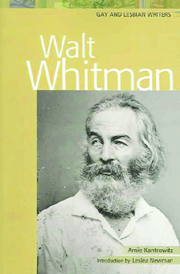Unmasking the poet’s queerness, offering a Baedeker to his works for a new generation
Most high school students are forced to suffer their way through “Oh Captain! My Captain!” which Kantrowitz accurately describes as having “a sing-song rhythm, a rigid rhyme scheme, and mawkish imagery to honor the fallen leader [Abraham Lincoln].” They are unlikely to be given the “Calamus” poems, in any of their versions, the originals with masculine pronouns, or the versions bowdlerized and cleaned up by the “Good Gray Poet” himself for mass-consumption, pronouns nicely changed to hide the sticky facts. (Kantrowitz is very good on Whitman’s reasons for this self-censorship.)
And they will probably have to wait—and be lucky enough—to go to a good college, with a good English department, with brave professors before they are informed that “the history of over a century of Whitman biography is to a large extent the history of a pussyfooting accommodation to the issue of sexuality and, more specifically, homosexuality. One sees biography being skewed in the interest of literary public relations.” This last quote is from Fred Kaplan, whose own “pussyfooting accommodation[s]” are described by Kantrowitz in the last chapter, “The Real Me,” a remarkably concise history of said pussyfooting.
This brief and thorough account is the perfect introduction to Whitman for young readers who manage to get hold of it. I wish it had been available when I was first reading Whitman. The opening chapter, “Do I Contradict Myself?” is perhaps too sophisticated for the intended audience and has a little too much of Whitman’s own spirit of fantasia—the easy, seamless drifting from one image, or theme to the next, all of it rooted in the poetry by the strong force field of Whitman’s vision—but no so easily followed in a scholarly work meant as an introduction for young readers. I am not a Whitman scholar but I do have a broad familiarity with his life and works and had to rely on my knowledge often to keep up with Kantrowitz’s well-informed and illuminating overview of the contradictions in Whitman’s life and poetic development, especially his complicated history of evasive answers to overly blunt questions.
However, by Chapter Two, “A Child Went Forth,” Kantrowitz has settled comfortably into his task and over the course of 160 pages provides a survey that moves gracefully back and forth from the poet’s life to his work. One of the pleasures of “Whitman” is the large number of well-chosen and extensive quotations from poems, letters, and journals. Underlying his narrative is a serious examination of the “the complex forces in this poetic giant’s life that enabled him to set a heroic example for other men who loved men by proclaiming his emergence from the closet into a new community while at the same time feeling ashamed enough to deny this central truth of his life.”
I can quibble with the assumption that it was shame and not simply sensible self-protection that led to Whitman’s famous denials but one of the strengths of the book is to examine whether or not Whitman “disguised himself so well that he would be remembered as a homophobe rather than as the courageous champion of ‘the love that dare not speak its name?’” Kantrowitz concludes that “Whitman’s talent for contradicting himself was able to save him,” and even finds a benefit in the academic effort “by so many critics in denying and defending the simple truth [of Whitman’s homosexuality], to wit, “if the author remains elusive in some ways, we are forced to pay more attention to his work.
Very few of us will ever pay as much attention as Kantrowitz has. The literature, primary and secondary, is voluminous. But with this guide in hand—there are excellent bibliographies of works cited, further reading as well as an index—both beginning and experienced Whitman explorers will have a much easier time finding their way through the forest.
gaycitynews.com


































